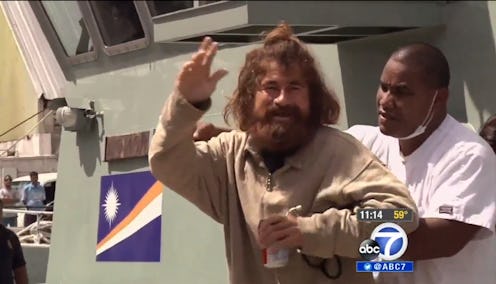News
6 Amazing Real-Life Castaway Stories

He's not pulling at our heartstrings yet like Tom Hanks and Wilson in the movie Cast Away, but Jose Salvador Alvarenga sure has a very compelling lost-at-sea story. Alvarenga says he was a castaway in the Pacific Ocean for 13 months, floating more than 5,000 miles from Mexico to the Marshall Islands, where he washed up Thursday. When he was brought to officials today in the Marshall Islands' capital, Majuro, Alvarenga says he survived from December 2012 until now by drinking rainwater and eating birds, fish, and turtles.
Officials are still trying to piece together Alvarenga's story in order to verify the legitimacy of it. Some are a tad bit skeptical because he is in relatively good health and doesn't appear skinny at all. Alvarenga, who says he's originally from El Salvador, told officials that he worked as a shark fisherman in Mexico. On Dec. 21, 2012, Alvarenga and a teen he knows only as Ezekiel were blown off course by a storm. But the teen died after only a month, while Alvarenga scooped up fish to eat and drank birds' blood — as well as his own urine.
He says he wanted to kill himself for a few days after the teen's death, but his belief in God kept him alive. When he tumbled onshore, he was wearing only underwear when two village women saw him. Alvarenga says he had relatives in the U.S. and a 10-year-old daughter in El Salvador.
Gee Bing, the acting secretary of foreign affairs for the Marshall Islands, says that he's a bit skeptical of Alvarenga's ordeal.
It does sound like an incredible story and I’m not sure if I believe his story. When we saw him, he was not really thin compared to other survivors in the past. I may have some doubts. Once we start communicating with where he’s from, we’ll be able to find out more information.
But if Alvarenga's story holds up, it could go down in history as one of the most amazing castaway stories ever, much like these historic tales.
Marguerite de la Rocque, Cast Away for Love
In 1542, French noblewoman Marguerite de la Rocque accompanied a relative, Jean-François de La Rocque de Roberval, on his voyage to Canada. But on the way, de Roberval found out Marguerite had fallen in love with a young crewmember — a big no-no. De Roberval then dropped off Marguerite, the lover, and Marguerite's maidservant at a remote island, Île des Démons, in the St. Lawrence River, where Marguerite bore a child. Even though everyone in the small group ended up dying, Marguerite was rescued by a passing fleet, who took her back to France.
Wow.
Juana Maria, The Lone Woman of San Nicolas Island
When the population of San Nicolas, a small island off the California coast, dropped down to a few dozen residents, Franciscan pastors built a ship to bring them all to the mainland. All but one woman made the journey, though — and her story ended up being the inspiration for the popular book The Island of the Blue Dolphins. Legend has it that Juana Maria, as she was later named, jumped off the ship when she realized her baby had been left behind.
The mystery around her grew over time, especially when a boat captain commissioned to find her could not locate a trace of her on the island. After 18 years, an interested Santa Barbara rancher George Nidever found the Lone Woman in 1853. In 2012, Navy archaeologist Steve Schwartz found what he believes (with 90 percent certainty) is the Lone Woman's cave.
Her story was also made into a popular 1964 movie.
Alexander Selkirk, the Real Robinson Crusoe
Robinson Crusoe, the central character of Daniel Defoe's novel, is perhaps the most famous castaway in popular culture. His story is based on the adventures of Scotsman Alexander Selkirk, who remained behind on an island in the Pacific n 1704 after a disagreement with the boat captain. He wasn't rescued until five years later.
In 2008, archeologists finally confirmed the whereabouts of Selkirk's campsite on the Argentinian island of Aguas Buenas, where researchers believe he set up two lookout shelters near a stream and passed his time by singing Bible psalms.
Steven Callahan, Life of Pi Consultant
In 1982, Steven Callahan survived on a raft for 76 days in the Atlantic Ocean after his boat capsized off the Canary Islands. In the midst of a storm, he grabbed whatever supplies he could and hopped into a life raft. But then, the raft detached from his boat and he was left to fend for himself. He made up exercise routines and thought up ways for measuring time. Mahi-mahi fish followed him across the ocean, his only companions.
"The fish offered me real companionship. They nourished me. They almost killed me. And in the end, they brought me salvation," he said.
He was eventually rescued by a fishing boat in Guadeloupe. When the movie Life of Pi began production, Callahan was hired as a consultant to share his story. Totally worth it?
Lucy Irvine, the Classified-Ad Castaway
The classified ad said "Writer seeks 'wife' for year on tropical island." Lucy Irvine, then 25 in 1981, was bored and looking for excitement. And that's how she ended up spending 13 months on a mile-long island off the coast of Australia, with a complete stranger twice her age. Irvine and Gerald Kingsland ended up surviving on seafood, coconuts, and the generosity of strangers from a neighboring island. But their relationship was less than paradise:
"I became a docile yes-girl, a nothing. The disintegration of my personality was frightening. I felt like a prostitute," Irvine recounts.
So, it seems to be true: No castaway love story is as good as the one between Tom Hanks and Wilson.
Image: WiffleGif